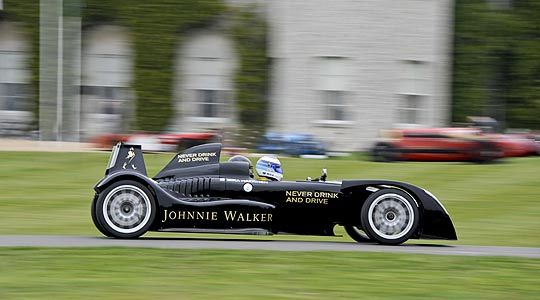
At this year's Goodwood preview I tasted two almost polar extremes of what we'll be seeing later in the year. We’ll get to the Caparo T1 and Mika Hakkinen a bit later, but first off: a rather special Skoda...
You don't tend to think of Skoda as a creator of racing cars. Rally cars, yes; works Skodas have long been on the international scene, even in the Iron Curtain days. But racing cars haven't figured much in the memory.
Imagine the interest, then, at last year's Le Mans Classic in which was entered the Skoda Sport originally run in the 1950 race. It was quick, it was pretty; and back in 1950 it led its class until the 13th hour when a retaining circlip on a gudgeon pin broke. Later, these Skoda Sports ran 1490cc engines with two superchargers, producing 180bhp, and they raced in Czechoslovakia with some success.
The Skoda Sports, and their cycle-winged Supersports derivatives, were based on the production 1101 Tudor saloon. In 1957 the factory tried a new approach, a bespoke sports-racing car with a tubular spaceframe chassis, a glassfibre body resembling a miniaturised Mercedes-Benz SLR, a rear-mounted five-speed transaxle with a multi-plate clutch rotating in an oil bath, inboard rear brakes and a very special version of the company's usual 1089cc engine.
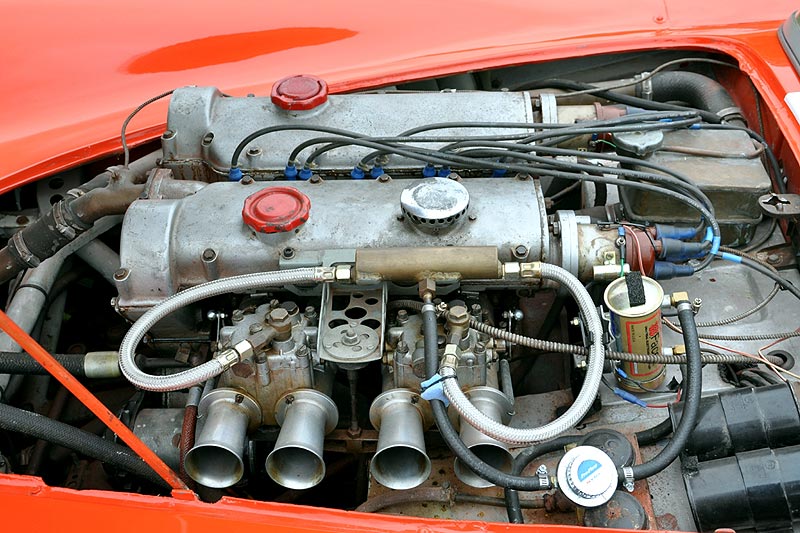
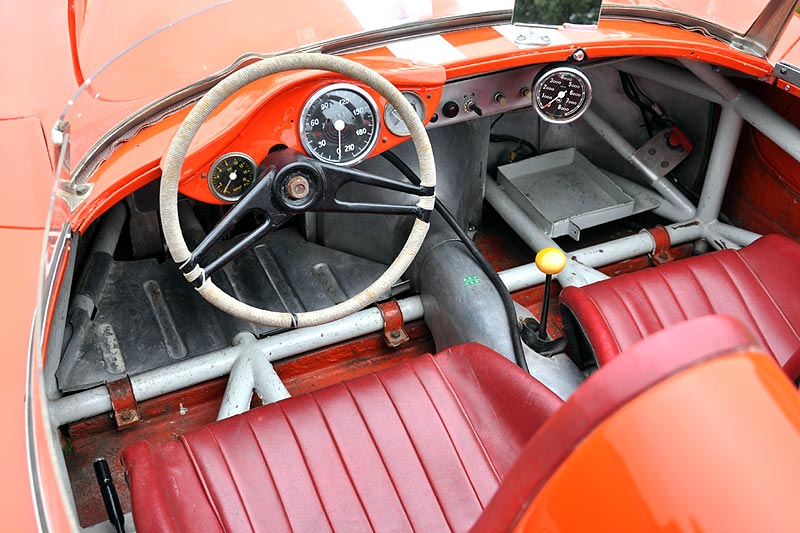
It can be no coincidence that the bore and stroke of this engine, and those of the larger 1221cc version, were identical to those of contemporary Fiat pushrod ohv units. There was surely some cross-pollination going on here. But the Skoda 1100 OHC Spider's cylinder head was something new and unique.
Look at the Spider's giant power bulge for a clue: it covers two hefty camshaft covers which top a specially-made cylinder head with efficient hemispherical combustion chambers, two spark plugs per cylinder, two coils and distributors to fire them, and two hefty, twin-choke sidedraught carburettors to feed the engine's appetite. These carburettors have no obvious markings, and they look more 'industrial' than Webers. They are Jikov 35s, and their induction trumpets snort with the best of them.

It's very low-slung; no wonder the engine-bulge bursts so far out of the surrounding bodywork. I am not remotely tall yet my shoulders are far above the Skoda's waistline and the small, thin-rimmed, cord-bound steering wheel is on my thighs. The other car has a bigger steering wheel, so how anyone fits beneath it I don't know.
Holes are drilled for lightness in all sorts of places. The wire wheels have aluminium rims and are held on with Skoda-badged knock-off nuts. The headlights are faired into the front wings, replacing the retractable units originally fitted into the front apron. Those aluminium door and bonnet hinges are also later additions, and the front air intake has lost its original bright-metal surround.
Delve more deeply and we find beautiful finned brake drums and torsion bar suspension. However, its geometry is still broadly that of contemporary Skoda saloons: the swing axle. Skoda's official history tome shows a great shot of both Spiders racing hard, the leading one's outside rear wheel tucking under hard as the driver winds on the opposite lock.
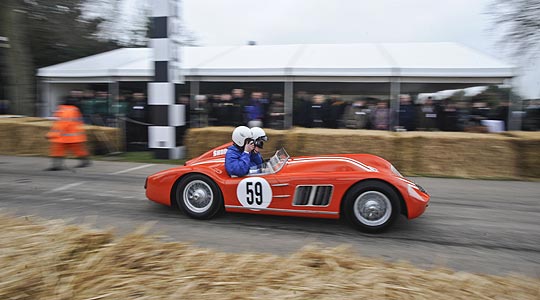
So the first corner on Goodwood's hill could be interesting. Featherweight door pulled shut. No seat belts. Master switch on, which instantly activates the electric fan. Pull switches for fuel pump and ignition. Pull a wire loop whose other end closes the starter's contacts. Churn-churn-splutter-vroooom! We're running, a touch unevenly at first until the fourth plug clears, then as crisply as you could wish. The handbrake doesn't work, because racing cars' handbrakes hardly ever do.
Into gear, to the left and back in this dogleg gate. It has synchromesh, but sympathy and proper revs-matching will help. Flag down, we're off. First gear is long-legged, all five ratios are close to each other, so a big footful of throttle is needed, upon which the Skoda bounds forward with an eager blare.
It's a revvy little engine, needing at least 4000rpm to wake it up, and it feels happy to go beyond the 6000rpm I set as a prudent limit (this cylinder head would be hard to replace if grenaded). The gearchange is swift, the steering quick and sharp once past the play typical of a worm-and-nut steering box. The Skoda turns in like a terrier, instantly leaning on the outside rear wheel, the tell-tale lack of body roll confirming that the dreaded tuck-under is only a twitch away. Good thing the retro-looking Uruguayan crossplies generate little grip.
More speed now, in fourth gear and revving keenly. There's said to be 92bhp available at 7700rpm, in a car which weighs just 550kg, and flat-out the 1100 OHC should reach 118mph. All feels great in a low-inertia, tail-out, 1950s sort of way until I try to brake hard for the blind bend by the wall. These drum brakes appear somewhat short of bite, but at least I was warned of this beforehand. No doubt they would improve in the heat of a race; drum brakes can be made to work very well, as I know from my own ancient Saab 96.
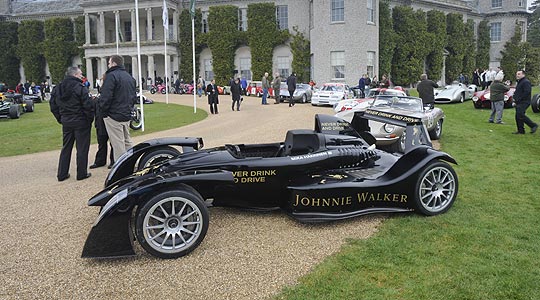
At the top of the hill I'm chuckling with the joy of piloting this little jewel of a racing car. Its creators would have liked to enter it at Le Mans and other international races, but politics and a lack of funds scuppered that plan. Instead the Spiders, and two aluminium-bodied coupés which followed, stayed behind the Curtain. Just two Spiders were made, the other one now residing in Skoda's museum. It's great that we can see this one in public at last.
And so from the Skoda to a car with 6.25 times the power: the Caparo T1. Here the 575kg, staggered-seating missile with its 575bhp, 3.5-litre V8, carbonfibre structure and F1-flavoured demeanour is in trackday trim, shorn of lights and stripped for action. But I am not to drive it. Instead I am to be hurled along Goodwood's further-flung access roads by one Mika Hakkinen, who should know what he's doing given that he was Formula One world champion in 1998 and 1999.
He's fully suited-up in his Johnnie Walker-liveried overalls but eschews the corporate helmet in favour of his own famous lid. He's the 'ambassador' for the whisky company's 'responsible drinking' campaign, promoting the evils of mixing drive and drink and the sense of appointing a 'designated driver' before everyone gets stuck in. Naturally he hasn't had a drop today, and nor have I. The helmet and the blue eyes are the only recognition points, apart from the Finnish tones of welcome as I squeeze in and rub shoulders rather intimately with my chauffeur.
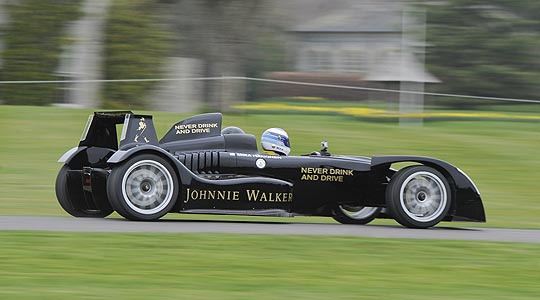
The Prince's Drive, the cattle-grids and the road through the woods to the distant barns are declared clear, and Hakkinen fires up the flat-crank V8 with the explosive awakening typical of an engine with a featherweight flywheel. And we're off. Blam-click-blam-click-blam up through the gears and the engine's strident bellow is boring right through my head. I have to keep turning it to spread the pain and stop it concentrating in one spot, so I have a chance of retaining some hearing. If I let my helmet rest on the engine cover behind it, where the g-forces naturally want to force it, the racket is even worse.
But, good grief, we're moving quickly. Quick lift for the cattle-grid, then back on the pace, trees flashing past, gloved and skilled hands nudging the Caparo at impossible speed with perfect accuracy just as they did throughout the Grands Prix of the 1990s. Now a doughnut flick in the farmyard and back we go, just as rapidly. Conversation is impossible, obviously. Then a flick left into the parking area and another doughnut as a final flourish. Engine off. Phew.
It was exciting for me, of course. But for my driver? How hard was he trying? “Oh, about 50 per cent, because there isn't space for any more and it wouldn't be safe.” Fair point, given how close we were to the trees on the single-track road.
We're walking back to Goodwood House, and Mika is smiling. He pats me on the back. Is the Caparo really anything like a Formula One car? “You can't really compare the weight and power ratio with an F1 car, because this is a road car. But it has 1000bhp per tonne, which I like.” Did Hakkinen ever drive a turbocharged F1 car, in which the power-to-weight ratio got really extreme? “My racing was after the turbo era, but I did drive Alain Prost's turbo McLaren in 2003. That was something…”
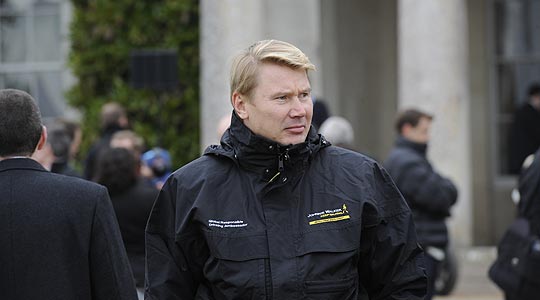
Nowadays Hakkinen manages new drivers instead of racing, but he never forgets the old days. I broach the subject of his huge accident in 1995, and how he fought back to become, eventually, a double champion. “It was a big impact. I think about it every day. I lost some hearing in my right ear; it's not a problem but I can't get rid of it.
“I came through thanks to McLaren and Mercedes, and the great support of the fans. I can't look in the mirror and say ‘I did it.’ I am not the centre of the universe, although it would be nice to be. My feet are on the ground.”
Text: John Simister
Photos: Michael Bailie / Skoda
ClassicInside - The Classic Driver Newsletter
Free Subscription!








